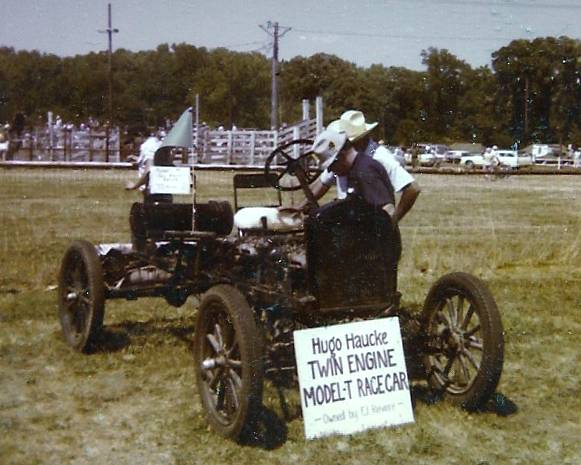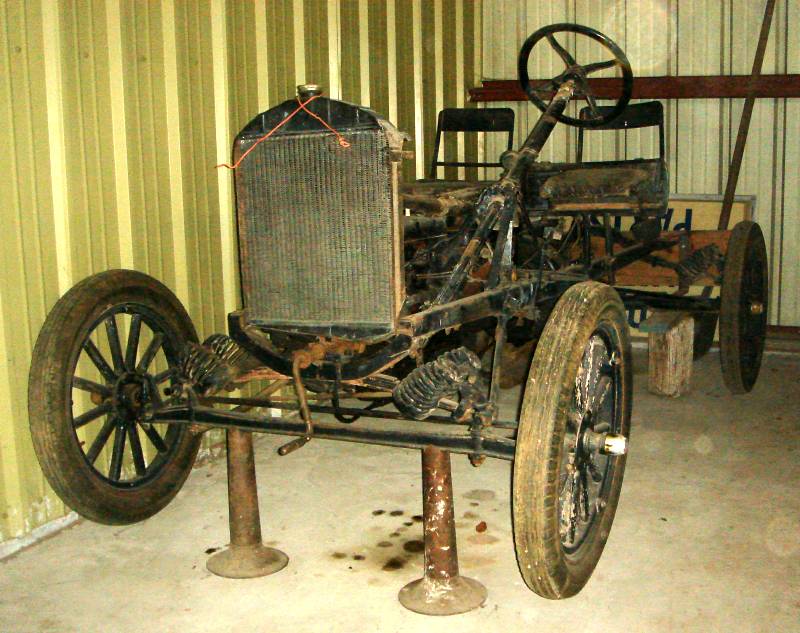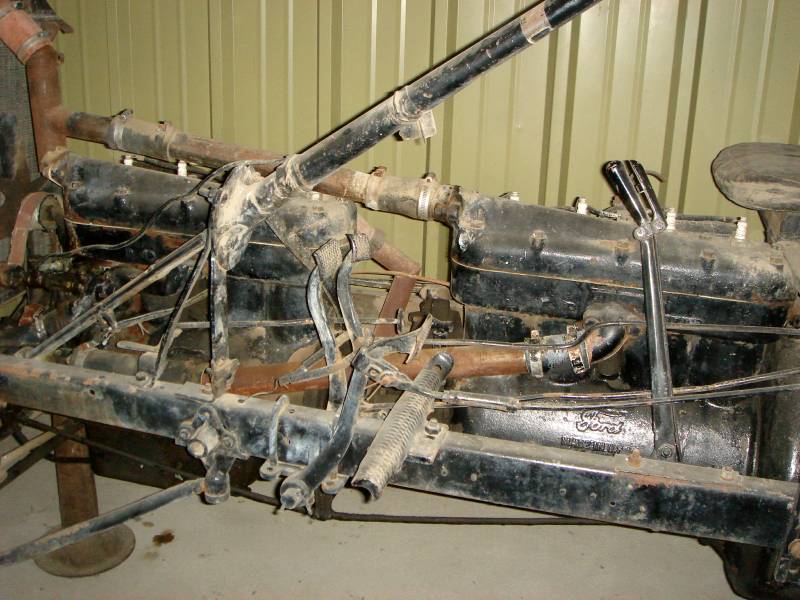Double Engine Model T Ford Racing Cars
|
Unidentified men examine the restored Hugo Haucke Model T. Ford racing car during a car show on the site of the old City Park racetrack on July 4, 1978 - Revere collection
|
|
Close-up of where the two engines in the Hugo Haucke Model T Ford connect - Lawrence collection
|
|
The restored Hugo Haucke double engine Model T Ford racing car on display in a car show at Council Grove, Kansas in 1985 - Revere collection
|
|
The two Motel T engines in Hugo Haucke's restored Model T Ford racing car - Lawrence collection
|
|
The pedals in the restored Hugo Haucke double engine Model T Ford racing car - Lawrence collection
|
|
The restored Hugo Haucke double engine Model T Ford racing car as it sits today in the Yesteryear Museum in Council Grove, Kansas - Lawrence collection
|
|
F. J. and Elizabeth Revere in the restored Hugo Haucke double engine Ford at a car show on the former site of the old City Park racetrack in Council Grove, Kansas on July 4, 1978 - Revere collection
|
|
The restored Hugo Haucke double engine racing car at a car show at the former site of the Fairgrounds Park racetrack on July 4, 1978 - Revere collection
|
|
Max Scholes and F. J. Revere in the restored Hugo Haucke double engine Ford racing car during Council Grove's Wah-Shun-Gah Days parade on July 4, 1983 - Revere collection
|
|
This photo of Hugo Haucke's restored double engine Ford racing car was taken in 1986 - Revere collection
|
|
The Model T Ford engines in the restored Hugo Haucke double engine Model T Ford racing car - Lawrence collection
|
|
The restored Hugo Haucke double engine Model T Ford racing car in the Yesteryear Museum in Council Grove, Kansas - Lawrence collection
|
There was a rather active automobile racing circuit in Northern Kansas and Southern Nebraska in the late teens and early 1920s. Some of the racetracks where they participated were at Abilene, Belleville, Blue Rapids, Bushong, Concordia, Council Grove, Salina, and Topeka in Kansas, as well as at North Platte in Nebraska. A few mechanics decided to build racing cars for that circuit that utilized two, four-cylinder Model T Ford engines placed end-to-end in an open chassis. It appears that these cars inspired other builders in the area to construct their own such creations. It currently appears that there were at least three of these racing cars although it is possible that two of those may have been the same car.
The earliest known of these double-engine cars was entered in the races at the Lincoln County Fairgrounds at North Platte, Nebraska on September 28, 1918 by the car’s owner, Charles D. Cruse (1889-1965) who owned an automobile repair business in Abilene, Kansas. The car was trucked to North Platte and then raced there by Harold Stanley” Doc” Roller (1893-1964), who was also from Abilene. Results of those races have yet to be located though. Cruse also entered that car in the races at the Kenwood Park Mile Speedway at Salina, Kansas on the weekend of September 3-4, 1919. Roller drove the car to the overall victory in the races that weekend, winning the total purse of $2,000 that had been posted by the organizers. Roller finished the final 20-lap race a full lap ahead of Harvey Demster who was driving a Peugeot automobile. Roller completed the twenty miles in 29 minutes, 39.2 seconds.
The following year found two or three of these double engine cars racing with the Morris County Racing Association on the City Park racetrack on the north edge of Council Grove, Kansas. One was driven by Roy "Blub" Robbins (1889-1959) of White City, Kansas and was described thus by John Gerber (1896-1979) on page 32 of his book, Outlaw Sprint Car Racer:
In those days, many new ideas were tried on racing cars and many different engines. I remember a fellow who raced at Council Grove who used two Motel T engines in tandem with a clutch between them. After getting started, he would clutch them to get both engines running in sync. The car had quite a lot of speed but it was impossible to balance the chassis to be stable in the turns. The eight cylinders made quite a racket without an exhaust pipe because the exhaust went directly into the air from the exhaust port.
It is possible that this was the same car that Doc Roller had driven at Salina a year earlier although that appears unlikely. Another double engine car that raced on the City Park racetrack that year was driven by John Wesley “Wes” Carson (1886-1936) of Garfield, Kansas.
The third (or fourth) such car, also racing with the Morris County Racing Association in 1920, was built, owned, and driven by Hugo Oscar Haucke (1880-1953), a Morris County farmer. In this car, the two engines had been welded together by Harry E. Blim (1887-1930) with the crank on the back engine 180° behind the front engine. Blim was the first acetylene welder in Morris County. According to the numbers stamped on the engines, one was from a 1917 Model T while the other was from a 1918 model. Both engines were bored out utilizing oversize pistons and each was fitted with a Bosch magneto and a Stromberg carburetor. The only brake was a transmission brake and that only stopped the drive wheel. The car was cooled with a Hudson radiator and usually had to be pushed to get it running, although Hugo Haucke was a strong man and is reported to have been able to start the two engines with the hand crank on the front of the front engine. The car had one bucket seat just to the left of the rear engine in its original racing configuration. The car had wire spoke wheels and the rear end gearing was 5.00:1 allowing it to run quite fast down the straightaways but, just as John Gerber described Robbins' Ford in 1920, the car was so light in the back that it was almost impossible to turn corners with at speed.
On Friday afternoon, May 28, 1920, Hugo Haucke set the fourth fastest time in time trials of the seven cars entered that day turning two laps in his double engine Ford in 1 minute, 19.75 seconds. He then finished third in a five-mile “Free-for-All” race. Next, Haucke won a five-mile race for Fords only he going the prescribed distance in seven minutes flat. All seven cars present that afternoon entered the final ten miles “Free-for-All” race but Haucke's double engine Ford overheated badly and would just barely muster enough power to complete the final lap where he officially finished in fifth place.
On Thursday afternoon, July 8, 1920, Hugo Haucke and "Blub" Robbins raced their two double engine Fords in a match race on the City Park racetrack with Haucke winning easily. Haucke then started on the pole of the ten-mile “Free-for-All” race and led until he was passed by Elmer "Tink" Snider (1889-1979) on the eighth lap. Snider was an automobile mechanic from Council Grove. Haucke dropped out of the event near the end when his back engine quit and Snider went on to win the race.
On Friday Afternoon, September 24, 1920, both Wesley "Wes" Carson and Hugo Haucke entered double engine Ford racing cars in races run on the City Park racetrack. In the three-mile race, Carson finished third which paid $15 in prize money while Haucke came in fourth. Haucke came back to win the first ten-mile “Free-for-All” in 11 minutes, 35 seconds that afternoon in his Ford picking up $150 in prize money while Carson finished in second place in his and collected $62.50. In the second of two five-mile “Free-for-All” races, Haucke again finished to win $102 for first while Carson came in second to pick up $42.50. Haucke then finished second in the final ten-lap “Free-for-All” of the day picking up another $62.50 in prize money.
On Friday afternoon, July 22, 1921, Hugo Haucke turned two laps (one mile) on the City Park racetrack in one minute, 9.5 seconds for the second fastest time trial of the afternoon behind that run by Earnest "E. C." Miller in his 16-valve, four-cylinder Buick. Miller then beat Haucke by four and one-half seconds in a three-mile “Free-for-All” race consisting of five cars. Haucke was one and one-half seconds ahead of third place finisher George Drashner (1898-1945) of Council Grove driving a Maxwell.
Frank Revere (1894-1983) of Council Grove led every lap of the ten-mile handicap race in his six-cylinder Buick. E. C. Miller finished in second place while Haucke was credited with third place.
Haucke led the first three laps of the five-mile “Free-for-All” race before fading to a fourth-place finish. E. C. Miller won that race followed by a Clarence Meyer from Council Grove in a Dodge and Revere. Miller then led every lap of the ten-mile “Free-for-All” race although his lead was challenged by Haucke from the beginning. On the second lap, Haucke tried to take a turn too fast and his car "skidded, buckled, turned, plunged off of the racetrack through a woven wire fence and overturned". The Ford came to rest upside down on top of Haucke. Hugo's father said of his injuries, "If it doesn't kill him, it might teach him a lesson." He was assisted from the car and rushed to a hospital where it was determined that his only injuries were severe bruises. He returned to the racetrack that same afternoon and was even seen walking around in Council Grove later that evening.
On Friday afternoon, October 7, 1921, Haucke finished in third place on the City Park racetrack in the ten-mile “Free-for-All” race behind John Mais of Salina, Kansas and Doc Roller who were both driving Dodges. Both of Haucke's engines were missing badly though.
On Saturday afternoon, October 15, 1921, Haucke dropped out of the three-mile “Free-for-All” race on the second lap on the City Park racetrack with a broken right front hub. That race was won by E. C. Miller in his 16-valve, four-cylinder Buick. Haucke was able to repair his Ford in time to start the ten-mile handicap race. Miller also won that race followed by George Drashner, Roy Lamb of Dunlap, Kansas in a Dodge; and Haucke in fourth place.
On August 22, 1922, Haucke finished second to George Drashner in the ten-mile “Free-for-All” race on the City Park racetrack.
On October 5, 1922, Haucke tied with Archie Bane for the fourth quickest time in time trials of the ten cars that took time trials that day, running two laps of the City Park racetrack in 1:10.4. On the second lap of the first heat race, he crashed into four other cars in what was reported to be the biggest pileup in the history of that racetrack. Hauck received some minor cuts and bruises in the accident but the car was not badly damaged.
Haucke is said to have hauled the car to Indianapolis, Indiana in the early '20s hoping to make his debut in big-time auto racing. There, he was told by race officials that his entry was being rejected as they did not allow any car with more than one engine in that race.
The number of races dropped off sharply on the Northern Kansas racing circuit after 1924 and the Morris County Racing Association ceased to function so Haucke put a touring car body on the car locating the front engine under the hood thus leaving the second engine sticking back through the firewall and into the middle of the front seat compartment of the car. At some point even later, the touring car body was removed though.
Haucke, who never married, still had the car when he passed away in October of 1953.
The following year, Hugo's brother, Frank F. "Chief" Haucke (1894-1977) gave what was left of the car to then high school senior Frank J. "F. J." Revere who had been a good friend of Hugo Haucke and had once offered to help him restore the double engine Ford racing car so it could be driven in parades. Revere knew the car was kept in a shed but he had never actually laid eyes on it until he went to pick it up. When he entered the shed, he still did not see the car. In one corner was an old rusted touring car body. When he looked inside that old body, he saw the frame and engines sunk down into the muddy dirt floor. The bucket seat and front axle were missing. The wire wheels had been replaced with wooden spoke wheels when the touring car body was installed but the back spokes were by now rotted and missing. The front engine had sunk into the mud up to the frame but the Model T engines turned over freely. Revere also located the magnetos on a shelf that was high enough that it saved them from flood damage. He also loaded up the touring car body, but it was so badly rusted that it just fell apart when he did.
It took about three months for Revere and some friends to restore the car to its racing form. The frame was suspended below the axels (underslung) when the car raced but it was raised and returned to the stock overslung position above the axels during the restoration. A Model A Ford radiator was installed to help with cooling during the parades and two Buick fold-down seats were installed. Just how much the engines had originally been bored out is unknown but the restoration included new F20 pistons meant to fit a Farmall tractor.
Revere drove the car in a number of Wah-Shun-Gah Days parades over the years and won first place in the Twin Lakes Car Club show in Council Grove in 1988 before donating the car to the Morris County Historical Society c2002. Today, the car is in the Yesteryear Museum in Council Grove.
Webmaster's note: The following article was found in a 1922 issue of Ford Owner and Dealer magazine:
An Eight-Cylinder Ford Racer
C. W. Hollingsworth, who conducts an automotive machine shop at Marshalltown, Iowa, has built a unique eight-cylinder race car. Two Ford engines in line furnish the power which is transmitted through a regular Ford transmission. The forward motor has the flywheel removed and is connected to the rear motor by means of a flange. Ignition is of the battery type using a specially built eight-cylinder distributor. A special body completed by Hollingsworh has been fitted to the chassis. The owner refuses to state how fast the car will go but offers a ride to the curious. One ride usually satisfies the curiosity.
This National Park brand stopwatch belonged to Hugo Haucke who used it to time his own lap times in the races as well as those of his competitors - Revere collection
Thank you to:
Sharon Haun, Bonnie McClintock, Bob More, F. J. Revere, Anne Revere-Lawrence, and Jim Taggart













